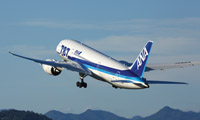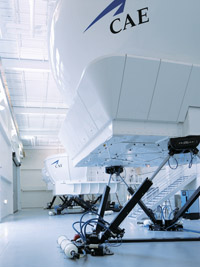Special Report: Training in the Asia-Pacific
Governments can act to ease crew shortages
More flight training academies are only part of the solution to meet demand for pilots in the Asia-Pacific.
April 1st 2014
Building pilot training academies are only part of the solution to the projected shortage of cockpit crew and technical staff at Asia-Pacific airlines, the region’s Association of Asia-Pacific Airlines told Orient Aviation. Read More »
 |
| 'If regulators had a harmonized approach in the transfer of qualifications it would then facilitate movement and alleviate potential shortages' |
| Martin Eran-Tasker Technical director AAPA |
The AAPA does not believe there will be a shortage of pilots and ground support and maintenance staff in the short-term and believes that regulators can help to alleviate the problem in the longer term.
Martin Eran-Tasker, technical director of the Association of Asia Pacific Airlines (AAPA), pointed out that some personnel resources are located in the wrong place. “The current regulatory environment prevents the easy movement of individuals as their qualifications need to be recognized and approved. There are no agreed standards or procedures on how such qualifications can be assessed and transferred.
“If regulators had a harmonized approach about the transfer of qualifications it would facilitate movement and alleviate potential shortages.
“However, responding to the medium and long term problem regulators and industry are taking action. We are seeing increases in training plus training joint ventures,” said Martin Eran-Tasker.
In the meantime, several of the region’s major airlines are setting up partnerships with training academies or airframe manufacturers to train the additional 192,300 pilots and 215,300 new technicians needed to service Asia-Pacific airlines in the next two decades.
Boeing forecast that in China alone, airlines will take delivery of 5,580 aircraft, which will triple its fleet (taking into account retirements). Bob Bellito, global sales director for Boeing Flight Services, predicted the additions to the Mainland fleet will require another 77,400 pilots and 93,900 engineers by 2032. Bellitto said: “There is a very real and urgent demand for competent aviation personal globally. The Asia-Pacific region is particularly impacted.
All Nippon Airways (ANA) is persuaded by the forcasts. In 2013, it allocated funds from its US$1.7 billion share sell to acquire Miami pilot training company, Pan Am Holdings, for $139.5 million. Some industry observers wondered if the carrier’s business sense had gone astray, but for the ANA Group boss, Shinichiro Ito, it was a critical investment.
He is considering using Pan Am Holdings, the last corporate vestige of the once famous and now defunct U.S. international carrier, Pan Am, as a platform for building a pilot-training facility in Thailand that will tap into the region’s demand for pilots, particularly in SouthEast Asia. The Pan Am acquisition was signed off at the same time as ANA bought a $25 million (49%) equity in Myanmar’s Asia Wings Airways. The training company will allow the Japanese airline group to offer training to airlines in the member countries of Association of South East Asian Nations (Asean), whose skies will be deregulated in 2015.
 |
| All Nippon Airways has invested US$1.7 billion in U.S. flight training academy |
Speaking at the recent Singapore Air Show, Bony Sharma, vice president of Singapore-based aviation training company, Mil-Com Aerospace Group said: “The airlines say: ‘OK, we’ve just bought a bunch of airplanes and we’ve put all our funding into the airplane’. Now, where does the funding come from to train the pilots, to train the engineers, to train even the management people, to keep these airplanes operational and safe and flying? That’s the biggest challenge that we’re facing.”
Mil-Com trains crews for a number of Asia-based airlines, including Vietnamese carrier, VietJet Air. In February, the budget airline ordered 63 new A320s, at an estimated value of $6.4 billion. It leased another seven planes and signed up for 30 options.
Sharma said that like many low-cost airlines, VietJet is struggling to recruit personnel because of an “extremely serious” shortage of pilots. “All the airlines in Vietnam are heavily dependent on international pilots. They’re competing from the same pool of pilots as the Middle East and with the growth of Singapore and the growth of AirAsia. It’s that same pool. It’s a big challenge in Vietnam,” said Sharma.
Mil-Com has been working with VietJet since it was founded in 2011, training engineers, technicians and cabin crew. In Singapore, the company and its partner, Eagle Flight Training of New Zealand, have signed a Memorandum of Understanding (MoU) with Vietnam’s Aerospace Engineering Services JSC (AESC), to open a flight school in Vietnam. “Even if we set up 100 airplane flying schools tomorrow, it still wouldn’t be enough, the shortage is that extreme,” he said.
The problem is far from being ignored. Boeing, with several partner airlines, runs pilot training schools in Singapore, South Korea, Australia, Japan and China. Airbus has a training school in Beijing and recently announced a joint venture with Singapore Airlines to set up a $64 million facility in Singapore offering full pilot training.
Boeing is expanding its training business in South Korea with the construction of the country’s largest aviation training facility in Incheon’s Free Economic Zone outside Seoul. When completed in 2015, the facility will be equipped with 12 full-flight simulators and will train pilots to crew the South Korean airline group’s fleet expansion.
| 'China alone will require 77,400 new pilots and 93,900 maintenance engineers in the next two decades' |
Part of the region’s demand for more cockpit crew will be met by companies beyond the Asia-Pacific. Global training provider, the United Kingdom’s CTC, has a flight academy in New Zealand that trains around 2,000 pilots annually. It will expand into Arizona in the U.S., in partnership with with Lufthansa Flight Training (LFT). The joint venture partners’ new academy will train up to 200 airline pilots a year and as well as cadet pilots from third party airlines including Asian carriers.
Most of the region’s major carriers have their own pilot and technician training schools, joint venture facilities or long-term training agreements with providers. Nearly all the airlines Orient Aviation contacted were planning for expansion.
Budget airlines, seen by many as a major cause of the problem because of the hundreds of new jets they have on order, are hardly sitting on their hands. One of the region’s fastest growing no-frills airlines, Indonesia’s Lion Group, which owns Lion Air, Wings Air, Malindo Air, Batik Air and Thai Lion Air, has more than 700 planes on order. It has 760 pilots with another 120 in training and expects it will require another 200 this year. It is setting up the Angkasa Aviation Academy and has on order 40 Cessna 172s valued at $15 million, as well as five CAE full-flight simulators: three B737s, one ATR and one A320. An airline spokesman said the carrier wants the academy to be sustainable and hopes to attract third-party business.
Malaysia’s AirAsia, currently the region’s largest LCC, with 475 A320 family jets on order, has partnered with simulator company, CAE, to make Kuala Lumpur its training hub for pilots, cabin crew, maintenance engineers and ground staff. In a five-year deal, CAE is training more than 200 new A320 first officers in a multi-crew pilot license (MPL) program.
Azran Osman-Rani, chief executive of long-haul LCC, AirAsia X said he is not worried about pilot shortages, despite impending deliveries of several aircraft in 2015. He plans to transfer experienced pilots from parent, the AirAsia Group, to train on wide bodies, with some captains recruited from outside Malaysia.
In the Philippines, successful LCC, Cebu Pacific, has set up the $50 million Philippine Academy for Aviation Training, also with CAE, to man its expanding fleet and capture regional third-party business.
 |
| CAE: big bussiness in the Asia-Pacific |
CAE has established a new pilot training operation in partnership with budget airline, IndiGo. The $25 million CAE Simulation Training Centre is based in Greater Noida, in the northern state of Uttar Pradesh in India, and provides A320 recurrent training to crews from IndiGo and another LCC, GoAir. The facility provides “wet” and “dry” type rating, recurrent, conversion and jet indoctrination training.
It operates two CAE Series 5000 A320 level-D full-flight simulators, has six simulator bays and plans to train more than 5,000 pilots a year by 2017. Marc Parent, president and chief executive of CAE, said the new facility’s location meant it was accessible to airlines in neighboring countries such as Nepal, Bhutan, Bangladesh and Myanmar.
Regional jet and turboprop manufacturers are also beefing up the region’s training muscle. Brazil’s Embraer has set up a Learning Centre with FlightSafety International at Singapore’s Seletar Aerospace Park to provide initial training, jet transition, type ratings and recurrent training for its E-jet range. And European turboprop maker, ATR, also has a new flight-training center at Seletar. Approved by the European Aviation Safety Agency (EASA), training programs include flight-crew type rating to recurrent training.
The facility has an ATR-600 series full-flight simulator that enables training for ATR 42-600s and ATR 72-600s variants, maintenance/flight simulation training devices and a brief/debrief station.
The challenges are complex, but they have happened in past times. As Randy Tinseth, Boeing’s vice president marketing puts it: “The market’s going to double in the next 15 to 20 years, but remember it doubled over the last 15 to 20 years that we’ve just come through.
“It’s something we can manage through, but we have to get out ahead of it. What we can do is partner with governments, partner with training agencies, partner with airlines and focus on a training curriculum that allows the training of those pilots.”